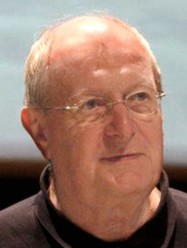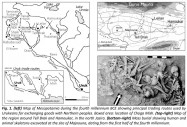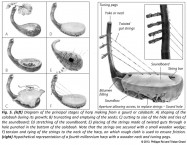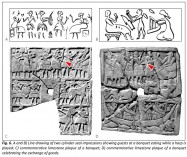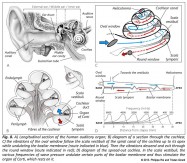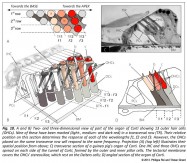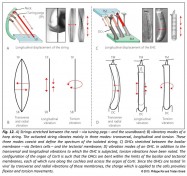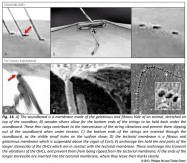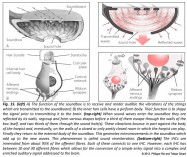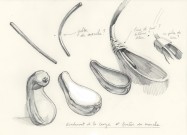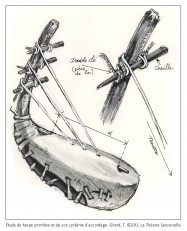Analogy between the Urukean Harp and the Auditory System
le 8 janvier 2014 | par Philippe Roi et Tristan GirardBy Philippe Roi(1), Tristan Girard(2), Richard Dumbrill(3), Michel Leibovici(4)
With the participation of Paul Avan(5)
(1)Researcher in Cognitive Science, specializing in Cognitive Archaeology ; (2)Researcher in Cognitive Science ; (3)Professor of Archaeomusicology, Director of ICONEA, Institute of Musical Research, School of Advanced Study, Universities of Oxford and London. (4)Doctor in Cellular and Molecular Biology, Paris VI University, Researcher at the CNRS, Cochin Institute, INSERM U1016. (5)Director of the Laboratory of Neurosensorial Biophysic, Clermont-Ferrand.
Abstract: During the fourth millennium BCE, in southern Mesopotamia, the Urukeans invented seven remarkable tools –the ard, the normalised brick mould, writing, accounting, the harp, the vertical weaving loom and the cone image– which the foundations of our civilisation still rely upon today. These inventions, among which was the primitive harp, have been found to mirror biological mechanisms which enable our sensory organs to perceive the world in which we live, and to codify it in order to transmit its representation to the brain. With regard to the primitive harp, its inspiration came from the organ of Corti, the sensory-nervous structure of the cochlea. A question remains as to how man could have created such an instrument at a time when the anatomy and physiology of the inner ear was impossible to perceive and comprehend. In order to answer this question, Philippe Roi and Tristan Girard have combined knowledge that was fragmented and separated into various fields, such as archaeomusicology, cell biology and neuroscience. This is how they discovered that there was a logical link between the Urukean harp and the organ of Corti.
Southern Mesopotamian elites would have increased their exchanges with those in northern Mesopotamia, in order to acquire more goods which distinguished them from the lower classes. As a consequence, there would have been an escalation of conflicts, as has been hypothesized after recent discoveries of mass burials in Syria at Majnouna, Hamoukar and Tell Brak, the latter being a significant strategic crossways (Fig. 1). In these burials, marks on the skeletons of hundreds, even thousands of young adults suggest a violent death.1 Deep test-pits in the main sites revealed evidence of northern Levantian and Anatolian raw materials which were converted locally into manufactured goods.2 Silt-rich southern Mesopotamian lands were ideally suited to agriculture and cattle husbandry. However, they did not yield any semi-precious stones, metals, wood, flint, basalt or obsidian, nor foodstuffs such as olive oil, wine or honey. The land did not produce any goods which could satisfy their rulers’ ostentatious frenzy, rulers whose power, conditioned by affectation, distinguished them from their peers and neighbouring cities. Cereals, and probably exceptionally fine long-fleeced ovines, were the only bartering goods traded with northern Mesopotamian villages.
Owing to the ard, northern Urukean breeders fed their herds with generous amounts of the wheat and barley they produced. When lambs are fed with high salt content cereals and hay, they develop the finest wool, which has a diameter of less than 11.8 microns.3 North and south would have bartered exotic goods for cereals and exceptionally long-fleeced ovines (Fig. 2). These exchanges would have led to lengthy arguments carried out in various dialects. At best, the deals ended in banquets and at worst, in blood feuds. History abounds with trade arguments leading to wars. A bloody massacre such as that at Tell Brak would have led to the antagonists finding ways to appease tension during negotiations. Urukeans developed one of the most subtle and ancient arts as a possible solution. This is substantiated by the emergence of harps fitted with three or four strings, as depicted on a fourth millennium seal impression from Choga Mish, east of Uruk in Elam, in modern south-west Iran (Fig. 3). The seal depicts a four-string arched harp played by a seated person, while two others beat a drum, a bowl-drum and clappers.4 As early as the fourth millennium, Urukeans would have discovered that harp music could unite people, allowing them to share feelings and emotions that they could otherwise only have experienced individually. This was the primary function of the harp: the music it produced would have facilitated the exchange of goods. From the beginning it promoted equal understanding; in other words, ‘all were in tune’. From then on, owing to the fact that the harp was a remarkable mediator, music would have been included in communication procedures between different communities, changing people’s mindset and developing empathy between them. Being the first to understand that music could have a significantly smoothing effect on those that listened to it, Urukeans found that it could also affect protagonists during negotiations. If music cannot change the product itself, it can unconsciously act favourably on the customer’s mood. The smoothing effect of the harp on bad tempers, and its contribution to emotional reactions, would have meant that the instrument had high status, from dawn to dusk. The harp was found in potters’ and weavers’ workshops, on goods barges, in banquets (Fig. 6) and even during sexual intercourse (Fig. 4-B). The Urukeans’ pride in their invention was so great that they engraved it on cylinder seals; in its silent manifestation, it sounded to the inner ears of those looking at its impression on seals and tablets. On tablets it was denoted by the Sumerian words BAN.TUR, BAN meaning ‘bow’ and TUR meaning ‘small’, hence harp, and the Sumerogram BALAG, voiced as the onomatopoeic ‘dubdub’, a word echoing the sound of the object it depicts. Around 3,300 to 3,000 BCE, the pictogram with which it is associated clearly depicted a harp with three or four strings (Fig. 4). However, 500 years later the word was used to denote a drum.5
Harps from Uruk and Djemdet Nasr were generally monoxyle or monostructural, meaning that there was no distinction between the soundbox and the part which would become the yoke, or the neck. They would have been made from gourds or calabashes, the natural shape of which were appropriate for this. It is possible that they were domesticated through simple cultivation techniques which made them grow in the shape of musical instruments. 6The dried fruit was hollowed out from an oval opening, which was then covered with a soundboard made from damp sheep, pig or calf raw hide. It was stretched at the back with wet hide strands. The strings were made from fresh twisted gut or vegetal fibres. A sliver of wood was tied at the end of each string, to prevent it slipping out of the soundboard during tuning. The upper ends of the strings were tied to a strip of woven material rolled around the neck, to ensure tuning by friction (Fig. 5-left). At that time, and especially towards the end of the fourth millennium, the size of soundboxes progressively increased while necks became thinner. Gourds and calabashes would still have been used for soundboxes, but necks would now be made of wood into which the Urukeans would later have plugged tuning pegs to ensure the tension of the strings (Fig. 5-right). Fourth millennium harps would have been small, with probably no more than three strings, stretched over a plan of around 110 degrees determined by the angle of the soundbox in relation to the neck. This suggests an anhemitonic disposition with a span of no more than a musical fifth, possibly including a third. These harps were always depicted in rural scenes, surrounded by animals, but with no reference to religious rituals; practical usage was thus implied, as is clearly shown on cylinder seals. However, from the third millennium onwards, harps were always shown in scenes depicting Inanna, the guardian Goddess of Uruk; they even symbolised her. Some texts record Inanna’s animals and her attributes, which included the reed, the palm, the aster Venus, and the harp itself.
Having described the harp in its original context, it is very clear that its design rests on the fundamental principle of hearing. Mankind’s perception of sound is an outstanding phenomenon. Sounds are simple periodical variations in air pressure which travel as a wavefront, at a speed of three hundred metres per second. When the waves reach our ear they are channelled into its canal and reach a thin membrane, the eardrum, which separates the middle ear from the outer ear. The vibrations of the eardrum, which result from variations in acoustic pressure, are transmitted to a chain of four small bones located in the stony part of the temporal bone: the hammer, the anvil, the lenticular bone and the stirrup. These ossicles articulate with each other. They are connected by ligaments, and transmit vibrations from the air environment of the middle ear to the aqueous medium of the inner ear, without any loss of energy. The inner ear is a complex structure in the temporal bones, consisting of a labyrinth and several liquid-filled cavities. This system is made up of canals, cavities and a spiralling structure called the cochlea. It is home to two very distinct sensory organs: the vestibular system, which detects and adapts to spatial body position, and the cochlea, which is the auditory receptor organ.
The cochlea, from the Latin meaning ‘snail’, is a small spiralling structure measuring 1.2 mm in diameter by 35 mm in length. It begins at the anterior part of the vestibule and rotates two and three quarter times around a bony pillar, the modiolus. At its lower end are the oval and round windows, which separate the middle ear from the inner ear. The cochlea is divided lengthwise into three chambers. On each side are the scala tympani and the vestibuli, both of which are filled with a liquid called perilymph. A cochlear duct is located between the two scalae; its lower part ends in the basiliar membrane, its upper part in Reissner’s membrane. The cochlear canal contains the organ of Corti, which is a complex system lying on the basilar membrane and extending right along the cochlea. This organ transforms vibrational energy into electric signals which the brain can interpret (Fig. 8). There are up to 15,000 outer hair cells spread over three or four rows, and 3,500 inner hair cells in one row (Fig. 9). The cellular bodies of the hair cells float in perilymph liquid, while hair bundles stand in the endolymph-filled cochlear canal. The ionic sealing of the cochlear canal is ensured both at its base by the reticular lamina, resulting from the tightly joined apical surfaces of hair cells and the supporting cells of the organ of Corti, and at its apex by Reissner’s membrane, which forms the ‘roof’ of the cochlear canal. When the stirrup moves under eardrum vibration pressure, it initiates motion of the incompressible scala vestibuli liquid. This motion reaches the top of the cochlea, reverses at the helicotrema, and finally runs down the scala tympani where it activates the round window placed at the other end of the system. The liquid movements initiate undulation of the basilar membrane, each part of which vibrates to a given frequency (Fig. 8-D). In turn these vibrations initiate displacements of the outer hair cells, which are rooted between the basilar membrane (by their basal pole, via Deiters cells), and the tectorial membrane (via their hair bundle) (Fig. 10). A relative alternating movement of the outer hair cells facing the tectorial membrane follows, provoking stereocilia deflection. Thus, the mechanical opening of the ionic channels results from a cellular depolarisation which leads to a rapid contraction of the outer hair cells, or electromotility, which then increases the amplitude of the basilar membrane vibrations. Consequently, this non-linear amplification phenomenon increases the weaker stimuli, which might not otherwise be perceived without interfering with high-intensity stimuli which would damage the inner hair cells, as a result of amplification. Because of this amplification, the stereocilia of the inner hair cells – which are the genuine sensory receptors of the auditory organ – are dragged in by the tectorial membrane and are also deflected. It follows that inner hair cell depolarisation releases neurotransmitter glutamate at its basal pole. This generates a spike train, sent to the brain by the auditory nerve.
An initial comparison can now be made between the neck of the harp and the basilar membrane (BM). The tuning pegs, around which the strings are wound and then driven into the neck, are comparable to the basilar membrane where Deiters cells are attached, and to which one of the ends of the outer hair cells (OHCs) is affixed. The neck is an essential part, because all the components of a harp rest on it, directly or indirectly. The functional importance of the basilar membrane is equally critical, because the various elements constituting the organ of Corti, again directly or indirectly, are attached to it. The harpist plucks the strings with greater or lesser intensity, his fingers complementing the work of the neck which the musician holds against his chest with his palm. Similarly, the sound vibrations transmitted by the perilymph generate upward and downward movements of the basilar membrane, at a precise location, resulting in the outer hair cells vibrating more or less intensely. As with the neck, the basilar membrane remains motionless right along the organ of Corti (Fig. 11-left).
A second comparison can be made between the tuning pegs inserted into the thick neck and Deiters cells (DCs), where the base is solidly affixed to the basilar membrane. The function of the tuning pegs is to secure the tension of the strings between the neck and the soundboard. Likewise, Deiters cells firmly grip the outer hair cells (OHCs) stretched between the basilar membrane (BM) and the tectorial membrane (TM). As for the clockwise or anti-clockwise rotation of the tuning pegs to tighten or relax the strings for tuning, the deformation of Deiters cells can modulate vibrations of the OHCs to which they are linked, as has recently been shown.7 They modify their membrane tension. This localised modification contributes to the refinement of the acoustic stimuli response (Fig. 11-right).
A third comparison may be drawn between the harp strings and the outer hair cells of the cochlea. One end of each string is wound around a tuning peg; the other is tied under the soundboard. This two-point attachment gives sufficient tension for their vibration, when plucked. This generates radial movement of the string as well as a light oscillation, as it is made of twisted material. A longitudinal wave propogation follows, starting from peg to soundboard. Similarly, the base of each outer hair cell is inserted in a Deiters cell, and its hair bundle is attached to the tectorial membrane. Thus secured, the OHCs generate rapid tension/relaxation cellular body motions – cellular electromotility – coupled with periodical oscillations of the hair bundle. Linked to electromotility, oscillations from the base of the OHC have been shown as leading to a radial displacement of the cell. It is important to add that the harp strings are only activated by plucking. Indeed, their arrangement does not allow for shortening of their speaking lengths, as is the case with the violin, for example. Each free string produces only one sound. In a similar way each transverse row of outer hair cells, in respect of its position along the organ of Corti and its structural characteristics, only responds to the stimulation of a single frequency (Fig. 12). Finally, in a manner similar to the work of the harpist’s fingers, which can dampen the vibrations of certain strings and allow others to sustain their sound – sometimes even sympathetically – numerous efferent fibres are projected from the central nervous system of the OHCs via the cholinergic synapses, in order to modulate their response intensity.8
A fourth comparison can be established between the soundboard and the tectorial membrane. The soundboard is a membrane made of fibrous/gelatinous animal hide stretched over the soundbox. One end of each string is driven through the soundboard, as can be seen from the holes when the strings are taken off. As the surface of the strings is very limited, the sound produced will have little intensity. However, if the string vibrations are transmitted to a larger surface, with better conduction, the sounds produced will be shorter but more intense. Not only does the soundboard amplify the signal originating from the vibration of the strings, it also transmits it to the soundbox. Similarly the tectorial membrane is also fibrous/gelatinous, and coats the organ of Corti. The ends of the outer hair cells’ longest ciliae are set in this membrane. Their surface shows hollow marks which are clearly visible with an electron microscope. When the OHCs vibrate, their hair bundles bend and amplify the relative motion between the basilar and the tectorial membranes. The signal which is thus amplified is transmitted to the inner hair cells. Therefore the tectorial membrane is paramount to the transmission of the sound stimulus, as is the soundboard (Fig. 13).
A fifth comparison can be made between the anchoring slivers and the tectorial membrane ties. String ties are thin slivers of wood placed horizontally under the soundboard. They contribute to the transmission of vibrations and prevent loosening of the knots at the lower extremities of the strings, without which they would slip under tension. Similarly, there are attachment ties under the thick tectorial membrane layer. Ties are needed to anchor the tip of the upper row of stereocilia of the OHCs’ hair bundles to the tectorial membrane (Fig. 14). This connection increases the vibration efficiency of the OHCs and, to a lesser degree, protects them from excessive tension.9
Finally, a sixth comparison can be observed between the soundbox (and its sound hole(s)) and the inner hair cell (and its afferent fibres). In organological terms, the soundbox is the part of a harp, the function of which is to gather and render audible the vibrations of strings and soundboard. When sound waves enter the soundbox, they reach its walls. The walls absorb some of the waves, while others bounce off them. The waves which are reflected converge and add to each other. This results in more perceptible sounds, most of which escape from the openings, or sound holes, placed at the base or sides of the soundbox. A third acoustic dimension adds to the two aforementioned ones generated by the strings and transmitted by the soundboard. This third acoustical element, generated by the soundbox, comes from the shape of the acoustical volume. It is the structure of the soundbox which shapes the sound. Additionally, however, the timbre is enriched by soundboard bars glued under it: they guide waves and enrich them euphonically (Fig. 15). Thus, depending on the complexity and quality of the bars, the timbre will result in more or less complex forms. This explains why the timbre and volume of instruments depend on their morphology. The inner hair cell (IHC) is the real sensory cell of the organ of Corti, since it perceives external stimulation and sends it to the brain. The IHC is mechanically stimulated by vibrations transmitted through the tectorial membrane deflecting the apical hair bundle. This deflection triggers a calcium influx at the base of the cell, which in turn generates a correlated neurotransmitter stimulation. This results in action potentials or spikes within the afferent nervous fibres. These are channelled via the auditory nerve to the superior nervous centres. It has therefore been shown that the pre- and postsynaptic components have a morpho-functional distribution which allows the IHC to shape its electric response.10 Thus, in a comparable manner, the soundbox and its sound holes, and the IHC and its afferent nervous fibres, both convert a simple entry signal (oscillation of the hair bundle) into a complex output signal.
NOTES
1 McMahon, A. (2007) Soltysiak, A. (2007).
2 Oates, J. (2007).
3 Lupton, C.J. et al. (2007).
4 Delougaz, P.P.; Kantor, H.J. (1972).
5 Dumbrill, R. (1998). Période au cours de laquelle les cités-États sont en guerre.
6 Dumbrill, R. (2012).
7 Yu, N.; Zhao, H.-B. (2009).
8 Frolenkov, G.I. (2006) Maison, S.F. et al. (2007) Richard, C. (2010).
9 Richardson, G.P. et al. (2008) Verpy, E.; Leibovici, M. et al. (2011).
10 Safieddine, S.; El-Amraoui, A.; Petit, C. (2012).
BIBLIOGRAPHY OF THE HARP
reni, C.S.; Kim, D., ‘The influence of background music on shopping behavior: Classical versus top-forty music in a wine store.’ Advances in Consumer Research. Vol. 20. Published by the Academic Resource Center (1993) pp. 336-340.
Biggs, R.D., ‘The Sumerian Harp.’ The American Harp Journal. Vol. 1/3. Published by The American Harp Society (1968) pp. 6-12.
Caubet, A., ‘La Musique à Ougarit : nouveaux témoignages matériels.’ Ugarit, Religion and Culture: Proceedings of the International Colloquium on Ugarit, Religion and Culture, Edinburgh, July 1994. Essays presented in honour of Professor John C.L. Gibson. N. Wyatt ; W. G.E. Watsonand ; J.B. Lloyd (ed.) (1996) pp. 9-31.
Chadefaux, D.; Le Carrou, J.-L.; Fabre, B.; Daudet, L.; Quartier, L., ‘Experimental Study of the Plucking of the Concert Harp.’ Proceedings of 20th International Symposium on Music Acoustics (Associated Meeting of the International Congress on Acoustics) 25-31 August, Sydney and Katoomba (2010) pp. 1-5.
Chadefaux, D.; Le Carrou, J.-L.; Buys, K.; Fabre, B.; Daudet, L., ‘Étude expérimentale du pincement d’une corde de harpe.’ Actes du 10ème Congrès Français d’Acoustique, Lyon, 12-16 Avril 2010. Publié en ligne (2010).
Chadefaux, D.; Le Carrou, J.-L.; Fabre, B.; Daudet, L., ‘Experimentally based description of harp plucking.’ Journal of Acoustical Society of America. Vol. 131/1. Published by the Acoustical Society of America, Melville (2012) pp. 844-855.
Collon, D., ‘La musique dans l’art mésopotamien.’ Dossiers d’Archéologie. N° 310. Éditions Faton (2006) pp. 6-15.
Delalleau, A.; Josse, G.; Lagarde, J.M., ‘Un modèle hyperélastique à réorientation de fibres pour l’analyse des caractéristiques mécaniques de la peau.’ 9ème Colloque Nationale en Calcul des Structures, Giens 2009. Communication publiée en ligne.
Delougaz, P.; Kantor, H., ‘Choga Mish – Volume I – The First Five Seasons of Excavations, 1961-1971.’ The University of Chicago – Oriental Institute Publications. A. Alizadeh (ed.) Vol. 101. Published by the Oriental Institute of Chicago (1996) Plate 45-N.
Delougaz, P.P.; Kantor, H.J., ‘New Evidence for the Prehistoric & Protoliterate culture development of Khuzestan.’ The Memorial Volume of the Vth International Congress of Iranian Art & Archaeology. Tehran – Isfahan – Shiraz. 11th – 18th April 1968. Vol. 1. Special Publication of the Ministry of Culture and Arts, Tehran (1972) pp. 14-33.
Dubé, L.; Chebat, J.-C.; Morin, S., ‘The effects of background music on consumers desire to affiliate in buyer-seller interactions.’ Psychology and Marketing. Vol. 12/4. Published by Wiley-Blackwell (1995) pp. 305-319.
Dumbrill, R., ‘Appendix.’ A Queen’s Orchestra at the Court of Mari: New Perspectives on the Archaic Instrumentarium in the Third Millenium. M. Marcetteau. ICONEA Proceedings 2008 (2008) pp. 73-75.
Dumbrill, R., ‘Harps.’ The Archaeomusicology of the Ancient Near East. Trafford Publishing (2005) pp. 179-226.
Dumbrill, R., Götterzahlen and Scale Structure (1997).
Dumbrill, R., ‘Music Theorism in Ancient World.’ ICONEA Proceeding 2009-2010 (2010) pp. 107-132.
Erman, A.; Ranke, H., ‘Les divertissements.’ La civilisation égyptienne. Éditions Payot (1985) p. 318.
Farmer, H.G., ‘The Music of Ancient Mesopotamia.’ New Oxford History of Music. Ancient and Oriental Music. Vol. 1. Published by Oxford University Press (1957) pp. 228-254.
Frankfort, H., Kingship and the Gods, a Study of Ancient Near Eastern religion as the Integration of Society and Nature. Published by the University of Chicago Press (1948).
Galpin, F.W., ‘The Sumerian Harp of Ur.’ Music & Letters. Vol. 10/2. Published by the Oxford University Press (1929) pp. 108-123.
Glattauer, A., À l’origine de la harpe. Éditions Buchet-Chastel (1999) pp. 13-23.
Guéguen, N.; Jacob, C.; Lourel, M.; Le Guellec, H., ‘Effect of Background Music on Consumer’s Behavior: A Field. Experiment in a Open-Air Market.’ European Journal of Scientific Research. Vol. 16/2. Published by the Scientific Research Platform – SRP (2007) pp. 268-272.
Hartmann, H., Die Musik der Sumerischen Kultur. Frankfurt am Main (1960).
Helmholtz, H.L.F., On the sensations of tone, as a physiological basis for the Theory of Music. Third Edition. Published by Longmans, Green and Co. (1865) reprinted by permission of Dover Publication, Inc. (1954).
Ivanov, V.V., ‘An Ancient Name of the Lyre.’ Archiv Orientální. Vol. 67. Published by the Oriental Institute, Academy of Sciences of the Czech Republic (1999) pp. 585-600.
Joannès, F., ‘Musique.’ Dictionnaire de la civilisation mésopotamienne. Éditions Robert Laffont (2001) pp. 545-546.
Kilmer, A., ‘The Cult Song with Music from Ancient Ugarit: Another Interpretation.’ Revue d’Assyriologie et d’Archéologie Orientale. Vol. 68. Éditions Presses Universitaires de France (1974) pp. 69-82.
Kilmer, A., ‘The Discovery of an Ancient Mesopotamian Theory of Music.’ Proceedings of the American Philosophical Society. Vol. 115. The American Philosophical Society (1971) pp. 131-149.
Kilmer, A., ‘Musik. A. I. In Mesopotamien.’ Reallexikon der Assyriologie und Vorderasiatischen Archäologie. Vol. 8. De Gruyter (1997) pp. 463-482.
Kilmer, A.; Crocker, R.L.; Brown, R.R., Sounds from Silence: Recent Discoveries in Ancient Near Eastern Music. Bit Enky Publications (1976).
Koitabashi, M., ‘Music in the Texts from Ugarit.’ Ugarit-Forschungen. Vol. 30. Ugarit-Verlag, Münster. Hubert & Co (1996) pp. 363-396.
rispijn, T.J.H., ‘Beitrage zur altorientalischen Musikforschung 1. Âulgi und die Musik.’ Akkadica. Vol. 70. Assyriological Center Georges Dossin (1990) pp. 1-27.
Lawergren, B., ‘Acoustics and Evolution of Arched Harps.’ The Galpin Society Journal. Vol. 34. Published by the Galpin Society (Oxford 1981) pp. 110-129.
Lawler, A., ‘Murder in Mesopotamia.’ Science. Vol. 317/5842. Published by AAAS (2007) pp. 1164-1165.
Lupton, C.J.; Huston, J.E.; Craddock, B.F.; Pfeiffer, F.A.; Polk, W.L., ‘Comparison of three systems for concurrent production of lamb meat and wool.’ Small Ruminant Research. Vol. 62/2. Official Journal of the International Goat Association. Published by Elsevier (2007) pp. 133-140.
Malamat, A., ‘Musicians from Hazor and Mari.’ Semitic and Assyriological studies presented to Pelio Fronzaroli. Harrassowitz Verlag (2003) pp. 355-357.
Marcetteau, M., ‘La musique au Proche-Orient ancien : l’approche des musicologues.’ Dossiers d’Archéologie. N° 310. Éditions Faton (2006) pp. 4-5.
Marcetteau, M., ‘A Queen’s Orchestra at the Court of Mari : New Perspectives on the Archaic Instrumentarium in the Third Millenium.’ ICONEA Proceedings 2008 (2008) pp. 67-73.
McMahon, A., ‘Report on the Excavations at Tell Brak, 2008.’ Newsletter of the British Institute for Study of Iraq. Vol. 22. Published by the British Institute for Study in Irak (2008) pp. 6-12.
McMahon, A., ‘Tell Brak 2007.’ Final Report. Published online (2007) pp. 1-7.
Menze, B.H.; Ur, J.A., ‘Mapping patterne of long-term settlement in Northern Mesopotamia at a large scale.’ Proceeding of the National Academy of Sciences – PNAS. Early Publication. Published by the National Academy of Sciences of the United States of America (2011) pp. 1-10.
Muldma, M., ‘La musique comme langue de communication dans le dialogue des cultures.’ Synergies – Pays Riverains de la Baltique. N° 6. Revue de Gerfint (2009) pp. 249-262.
Muldma, M., ‘Music as a Meeting Point of Cultures’. Education in Multicultural Environment, Dialogue of Cultures – Possibility or Inevitability ? Tome II. Tallinn University (2009) pp. 287-299.
Nemet-Nejat, K.R., ‘Music.’ Daily life in Ancient Mesopotamia. Published by Greenwood Press (1998) pp. 167-170.
Oates, J., ‘Archaeology in Mesopotamia: Digging Deeper at Tell Brak.’ Albert Reckitt Archaeological Lecture. Published by the British Academy (2004).
Oates, J.; Oates, D., ‘The Reattribution of Middle Uruk Materials at Brak.’ Leaving No Stones Unturned, Essays on the Ancient Near East and Egypt in Honor of Donald P. Hansen. Published by Eisenbrauns (2002) pp. 145-154.
Oates, J.; Oates, D., ‘The Role of Exchange Relations in the Origins of Mesopotamian Civilization.’ Explaining social change: studies in honour of Colin Renfrew. Published by the McDonald Institute for Archaeological Research, University of Cambridge (2004) pp. 177-192.
Oates, J.; Oates, D., ‘An Open Gate: Cities of the Fourth Millennium BC (Tell Brak 1997).’ Cambridge Archaeological Journal. N° 7. Published by The Cambridge University Press (1997) pp. 287-297.
Osses Adams, L., ‘Sumerian Harp from Ur.’ The American Harp Journal. Vol. 19/ 2. Published by the American Harp Society (2003) pp. 9-13.
Rebatet, L., Les Orchestres de Sumer. Une histoire de la musique. Éditions Robert Laffont (1973) pp. 17-29.
Risset, J.-C., ‘La musique et les sons ont-ils une forme ?’ La Recherche. Vol. 305. Éditions Sophia Publications (1998) pp. 98-102.
Rival, M., ‘Les instruments de musique au 4e millénaire.’ Les grandes inventions. Éditions Larousse (1994) pp. 40-41.
Ruwet, N., ‘Musicologie et linguistique.’ Étude international sur les tendances principales de la recherche dans les sciences de l’homme. Unesco/SS/41/3.244.1/h/24 (1966).
Schaeffner, A., ‘Travail et jeu.’ Origine des instruments de musique. Éditions EHESS (1994) pp. 95-108.
Seidel, H., ‘Musik und Religion. Altes und Neues Testament.’ Theologische Realenzyklopädie. Vol. 23. Éditions de Gruyter (1994) pp. 441-446.
Selz, G.J., ‘The Holy Drum, the Spear, and the Harp: Towards an Understanding of the Problems of Deification in Third Millennium Mesopotamia.’ Sumerian Gods and Their Representations. Published by STYX Publications (1997) pp. 167-213.
Shehata, D., ‘Les instruments de musique au Proche-Orient Ancien.’ Dossiers d’Archéologie. N° 310. Éditions Faton (2006) pp. 16-22.
Sloboda, J.A., ‘The Musical Mind, The Cognitive Psychology of Music.’ Oxford Psychology Series. N° 5. Published by Clarendon Press (1994).
Soltysiak, A., ‘Preliminary Report on Human Remains from Tell Majnuna (spring 2007).’ Excavations at Tell Brak 2006-2007. Published by the British Institute for Study in Irak (2007) pp. 161-163.
Soltysiak, A., ‘Short Fieldwork Report: Tell Majnuna (Syria), Season 2006.’ Bioarchaeology of the Near East. Vol. 2. Published online on www.anthropology.uw.edu.pl (2008) pp. 77-94.
Spycket, A., ‘La musique instrumentale mésopotamienne.’ Journal des savants. Vol. 3. Publication de l’Académie des Inscriptions et Belles Lettres. Diffusion De Boccard (1972) pp. 158-162. Tillmann, B., ‘La musique, un langage universel ?’ Pour la Science. N° 373. Éditions Belin (2008) pp. 124-138.
Valette, C.; Cuesta, C., Mécanique de la corde vibrante. Éditions Hermès (1993).
Wilson, S., ‘The effect of music on perceived atmosphere and purchase intentions in a restaurant.’ Psychology of Music. Vol. 31/1. Published by Sage Publications (2003) pp. 93-112.
BIBLIOGRAPHY OF THE AUDITORY SYSTEM
Alexander C.; Meyer, A.C. et al.,‘Tuning of synapse number, structure and function in the cochlea.’ Nature Neuroscience. Vol. 12/4. Nature Publishing Group (2009) pp. 444-453.
Arnold, W.; Anniko, M., ‘Supporting and membrane structures of human outer hair cells: evidence for an isometric contraction.’ ORL – Journal for Oto-Rhino-Laryngology and its related specialties. Vol. 51/6. Published by Karger (1989) pp. 339-353.
Ashmore, J., ‘Cochlear Outer Hair Cell Motility.’ The American Physiological Society. Vol. 88. Published by Wiley & Sons (2008).
Ashmore, J. et al., ‘The remarkable cochlear amplifier.’ Hearing Research. Vol. 266. Published by Elsevier (2010) pp. 1-17.
Bear, M.F.; Connors, B.W.; Paradiso, M.A.; Nieoullon, A., ‘Physiologie de la cochlée.’ Neurosciences. À la découverte du cerveau. 2e édition. Éditions Pradel (2002) pp. 370-389. Bremond, G. A., ‘Aspect général du labyrinthe et de son contenu conjonctif.’ L’oreille dans le temporal. Anatomie descriptive, topographique et systématisation. Éditions Solal (1994) pp. 14-44.
Breuskin, I.; Bodson, M.; Thelen, N.; Thiry, M.; Nguyen, L.; Belachew, S.; Lefebvre, P.P.; Malgrange, B., ‘Strategies to regenerate hair cells: Identification of progenitors and critical genes.’ The Journal of Hearing Research. Vol. 236/1-2. Published by Elsevier (2007) pp. 1-10.
Brownell, W.E., ‘Outer Hair Cell Electromotility and Otoacoustic Emissions.’ Ear Hear. Vol. 11/2. Published by Williams & Wilkins (1990) pp. 82-92.
Brownell, W.E.; Spector, A. A.; Raphael, R. M.; Popel, A. S., ‘Micro and nanomechanics of the cochlear outer hair cell.’ Annual Review Biomedical Engineering. Vol. 3. Published by Annual Reviews (2001) pp. 169-194.
Buser, P.; Imbert, M., ‘General structure of the sounds of musical instruments.’ Audition. The Physiological Psychology of Hearing. Vol.3.Massachusetts Institute of Technology (1992) pp. 95-111.
Cai, H.; Shoelson, B.; Chadwick, R.S., ‘Evidence of Tectorial Membrane Radial Motion in a Propagating Mode of a Complex Cochlear Model.’ PNAS (Proceedings of the National Academy of Sciences). Vol. 1/16. Published by the National Academy of Sciences of the United States of America (2004) pp. 6243-6248.
Corey, D. P.; Hudspeth, A. J., ‘Ionic basis of the receptor potential in a vertebrate hair cell.’ Nature. Vol. 281/5733. Published by Macmillan Journals Ltd (1979) pp. 675-677.
Dallos, P., ‘The Active Cochlea.’ The Journal of Neuroscience. Vol. 12/12. Published by The Society for Neuroscience (Washington 1992) pp. 4575-4585.
DeRosier,; D. J. Tilney, L. G., ‘The Structure of the Cuticular Plate, an In Vivo Actin Gel.’ The Journal of Cell Biology. Volume 109/6. Published by the Rockefeller University Press (1989) pp. 2853-2867.
Dulguerov, P.; Brownell, W. E., ‘Physiologie cochléaire.’ Précis d’audiophonologie et de déglutition. L’oreille et les voies de l’audition. Vol. 1. Éditions Solal (2005) pp. 57-79.
Eddine, C.A.; Williams, M.; Ayache, D., ‘Radio-anatomie utile de l’oreille.’ Journal of Radiology. Vol. 87. Éditions Elsevier Masson (2006) pp. 1728-1742.
Edeline, J.-M., ‘Anatomie et physiologie des voies auditives centrales : le système thalamo-cortical – L’oreille et les voies de l’audition’. Précis d’audiophologie et de déglutition. Tome I. Éditions Solal (2005) pp. 97-110.
Etournay, R.; Lepelletier, L.; Boutet de Monvel, J.; Michel, V.; Cayet, N.; Leibovici, M.; Weil, D.; Foucher, I.; Hardelin, J.-P.; Petit, C., ‘Cochlear outer hair cells indergo an apical circumference remodeling constrained by the hair bundle shape.’ Development. Vol. 137. Published by The Company of Biologists Ltd (2010) pp. 1373-1383.
Fettiplace, R.; Hackney, C.M., ‘The sensory and motor roles of auditory hair cells.’ Nature Reviews Neuroscience. Vol. 7. Published by Macmillan Journals Ltd (2006). pp. 19-29.
Forge. A.; Wright, T., ‘The molecular architecture of the inner ear.’ British Medical Bulletin. Vol. 63. Published by The British Council (2002) pp. 5-24.
Fraisse, P., ‘L’anticipation des stimuli rythmiques. Vitesse d’établissement et précision de la synchronisation.’ L’année psychologique. Vol. 66/1. Éditions Armand Colin (1966) pp. 15-36.
Fridberger, A.; Boutet de Monvel, J.; Zheng, J.; Hu,N.; Zou, Y.; Ren, T.; Nuttall,A., ‘Organ of Corti Potentials and the Motion of the Basilar Membrane.’ The Journal of Neuroscience. Vol. 2/45. Published by Wiley & Sons (2004) pp. 10057-10063.
Fuchs, P.A., ‘Time and intensity coding at the hair cell’s ribbon synapse.’ Journal of Physiology. Vol. 566/1. Published by The Physiological Society (2005) pp. 7-12.
Furness, D.N.; Mahendrasingam, S.; Ohashi, M.; Fettiplace, R.; Hackney, C.M., ‘The Dimensions and Composition of Stereociliary Rootlets in Mammalian Cochlear Hair Cells: Comparison between High- and Low-Frequency Cells and Evidence for a Connection to the Lateral Membrane.’ The Journal of Neuroscience. Vol. 28/25. Published by the Society for Neuroscience (2008) pp. 6342-6353.
Ghaffari, R.; Aranyosi, A.J.; Freeman, D.M., ‘Longitudinaly propagating traveling waves of the mammalian tectorial membrane.’ PNAS (Proceedings of the National Academy of Sciences). Vol. 104/42. Published by the National Academy of Sciences of the United States of America (2007) pp. 16510-16515.
Ghaffari, R.; Aranyosi, A.J.; Richardson, G.P.; Freeman, D.M., ‘Tectorial membrane travelling waves underlie abnormal hearing in Tectb mutant mice.’ Nature Communications. Vol. 1/96. Published by Nature Publishing Group (2010) pp. 1-6.
Gummer, A.W.; Hemmert, W.; Zenner, H.P., ‘Resonant tectorial membrane motion in the inner ear: Its crucial role in frequency tuning.’ PNAS (Proceeding of the National Academy of Sciences). Neurobiology. Vol. 93. Published by the National Academy of Sciences of the United States of America (1996) pp. 8727-8732.
Hanaway, J.; Woosley, T.A.; Gado, M.H.; Roberts, M.P., ‘Voies de l’audition.’ Atlas du cerveau. Un guide visuel du système nerveux central humain. Éditions De Boeck Université (2001) pp. 206-207.
Helmholtz, H.L.F., On the Sensations of Tone as a Physiological basis for a Theory of Music. Third Edition. Published by Longmans, Green, and Co. Aberdeen University Press (1895) reprinted by permission of Dover Publication, Inc. (1954).
Hemmert, W.; Zenner, H-P.; Gummer, A. W., ‘Three-Dimensional Motion of the Organ of Corti.’ Biophysical Journal. Vol. 78. Published by Cell Press (2000) pp. 2285-2297.
Imbert, M., ‘L’oreille et l’audition.’ Traité du cerveau. Éditions Odile Jacob (2006) pp. 233-248.
Kamina, P., ‘Voies cochléaires.’ Anatomie clinique. Tome 5. Éditions Maloine (2008) pp. 78-81.
Lewald, J.; Karnath, H.-O., ‘Vestibular Influence on Human Auditory Space Perception.’ Journal of Neurophysiology. Vol. 84/2. Published by The American Physiological Society (2000) pp. 1107-1111.
Lim, D., ‘Cochlear anatomy related to cochlear micromechanics’. Journal of Acoustical Society of America. Vol. 67/5. Published by the Acoustical Society of America, Melville (1980) pp. 1686-1695.
Lim, K.M.; Steele, C.R., ‘A three-dimensional nonlinear active cochlear model analyzed by the WKB-numeric method.’ Hearing Research. Vol. 170. Published by Elsevier (2002) pp. 190-205.
Augusto, L.S.C.; Kulay, L.A.; Franco, E.S., ‘Audition and exhibition to toluene – a contribution for the theme.’ International Archives of Otorhinolaryngology. Vol. 16/2. Open Access Journal (2012) pp. 246-258.
Lukashkin, A.N.; Lukashkina, V.A.; Legan, P.K.; Richardson, G.P.; Russell, I.J., ‘Role of the Tectorial Membrane Revealed by Otoacoustic Emissions.’ Journal of Neurophysiology. Vol.91/1. Published by The American Physiological Society (2004) pp. 163-171.
Marieb, E.N., ‘Oreille : ouïe et équilibre.’ Anatomie et physiologie humaines. Adaptation de la 6e édition américaine par R. Lachaîne. Éditions Pearson Education France (2005) pp. 599-608.
Marieb, E.N.; Hoehn, K., ‘The Ear: Hearing and Balance.’ Human Anatomy and Physiology. Seventh Edition. Published by Pearson Education (2004) pp. 583-592.
Nam, J.H.; Fettiplace, R., ‘Force Transmission in the Organ of Corti Micromachine.’ Biophysical Journal. Vol. 98. Published by Cell Press (2010) pp. 2813-2821.
Nilsen, K.E.; Russell, I.J., ‘Timing of cochlear feedback: spatial and temporal representation of atone across the basilar membrane.’ Nature Reviews Neuroscience. Vol. 2/7. Published by Macmillan Journals Ltd (1999) pp. 642-648.
Pritchard, T. C.; Alloway, K.D., ‘Système auditif.’ Neurosciences médicales. Les bases neuroanatomiques et neurophysiologiques. Éditions De Boeck Université (2002) pp. 277-298.
Pritchard, T.C.; Alloway, K.D., ‘Auditory System.’ Medical Neuroscience. First Edition. Fence Creek Publishing (1999) pp. 229-247.
Purves, D. Augustine, G. J. Fitzpatrick, D. Katz, L. C. Lamantia, A.S. McNamara, J.O., ‘Le système auditif.’ Neurosciences. Traduction de la 3e édition américaine par Jean-Marie Coquery. Éditions De Boeck (2005) pp. 283-314.
Purves, D.; Augustine, G.J.; Fitzpatrick, D.; Hall, W.C.; Lamantia, A.-S.; McNamara, J.O., ‘The Auditory System.’ Neuroscience. Third Edition. Published by Sinaur Associates Inc. (2004) pp. 283-314.
Raphael, Y.; Altschuler, R.A., ‘Structure and innervation of the cochlea.’ Brain Research. Vol.60. Published by Elsevier (2003) pp. 397-422.
Ren, T., ‘Longitudinal pattern of basilar membrane vibration in the sensitive cochlea.’ Proceeding of the National Academy of Sciences. Vol. 99/26. Published by the National Academy of Sciences of the United States of America (2002) pp. 17101-17106.
Richardson, G.P.; Lukashkin, A.N.; Russell, I.J., ‘The tectorial membrane: One slice of a complex cochlear sandwich.’ Current Opinion in Otolaryngology & Head and Neck Surgery. Vol. 16/5. Published by Lippincott Williams & Wilkins (2008) pp. 458-464.
Rival, M., ‘Musique et mathématiques.’ Les grandes inventions. Éditions Larousse (1994) p. 40.
Safieddine, S.; El-Amraoui, A.; Petit, C., ‘The Auditory Hair Cell Ribbon Synapse: From Assembly to Function.’ Annual Review of Neuroscience. Vol. 35. Published by Annual Reviews (2012) pp. 509-528.
Santos-Sacchi, J., ‘Functional motor microdomains of the outer hair cell lateral membrane.’ Pflügers Archiv European Journal of Physiology. Vol. 445. Published by Springer (2002) pp. 331-336.
Shoelson, B.; Dimitriadis, E.K.; Cai,H.; Kachar, B.; Chadwick, R.S., ‘Evidence and Implications of Inhomogeneity in Tectorial Membrane Elasticity.’ Biophysical Journal. Vol. 87. Published by Rockefeller University Press (2004) pp. 2768-2777.
Stepanyan, R.; Belyantseva, I.A.; Griffith, A.J.; Friedman. T,B.; Frolenkov. G.I., ‘Auditory mechanotransduction in the absence of functional myosin-Xva.’ The Journal of Physiology. Vol. 576/3. Published by the Cambridge University Press (2006) pp. 801-808.
Temchin, A.N.; Recio-Spinoso, A.; Cai, H.; Ruggero, M.A., ‘Traveling Waves on the Organ of Corti of the Chinchilla Cochlea: Spatial Trajectories of Inner Hair Cell Depolarization Inferred from Responses of Auditory-Nerve Fibers.’ The Journal of Neuroscience. Vol. 32/31. Published by The Society for Neuroscience (2012) pp. 10522-10529.
Tilney, L.G.; Derosier, D.J.; Mulroy, M.J., ‘The Organization of Actin Filaments in the Stereocilia of Cochlear Hair Cells.’ The journal of Cell biology. Vol. 86/1. Published by the Rockefeller University Press (1980) pp. 244-259.
Tsuprun, V.; Santi, P., ‘Ultrastructural organization of proteoglycans and fibrillar matrix of the tectorial membrane.’ Hearing Research. Vol. 110/1-2. Published by Elsevier (1997) pp. 107-118.
Ulfendahl, M.; Flock, A., ‘Outer Hair Cells Provide Active Tuning in the Organ of Corti.’ Physiology. News in Physiological Sciences. Vol. 13. Published by Waverly Press (1998) pp. 107-111.
Verpy, E.; Leibovici, M.; Michalski, N.; Goodyear, R.; J. Houdon, C.; Weil, D.; Richardson, G. P.; Petit, C., ‘Stereocilin connects outer-hair-cell stereocilia to one another and to the tectorial membrane.’ The Journal of Comparative Neurology. Vol. 519/2. Published by the Wistar Institute of Anatomy and Biology (2011) pp. 194-210.
Vranceanu, F.; Perkins, G.A.; Terada, M.; Chidavaenzi, R.L.; Ellisman, M.H.; Lysakowski, A., ‘Striated organelle, a cytoskeletal structure positioned to modulate hair-cell transduction.’ PNAS (Proceeding of the National Academy of Sciences). Vol. 109/12. Published by the National Academy of Sciences of the United States of America (2012) pp. 4473-4478.
Yu, N.; Zhao, H-B., ‘Modulation of Outer Hair Cell Electromotility by Cochlear Supporting Cells and Gap Junctions.’ Plos One : www.plosone.org. Vol. 4/11. Published online (2009).
Zetes, D.E.; Steele, C.R., ‘Fluid-structure interaction of the sterocilia bundle in relation to mechanotransduction.’ Journal of Acoustical Society of America. Vol. 101/6. Published by the Acoustical Society of America (1997) pp. 3593-3601.
Zheng, J.; Shen, W.; He, D.Z.Z.; Long, K.B.; Madison, L.D.; Dallos, P., ‘Prestin is the motor protein of cochlear outer hair cells.’ Nature. Vol. 405. Nature Publishing Group (2000) pp. 149-155.
In book (for the original French version), La Théorie Sensorielle. I – Les Analogies Sensorielles (2013) Roi, P. & Girard, T. Published by First Edition Design Publishing. Library of Congress Cataloging in Publication Data. Dépôt légal à la Bibliothèque royale de Belgique.
All rights reserved ©2013. Philippe Roi and Tristan Girard


